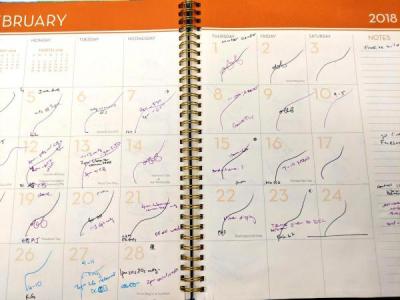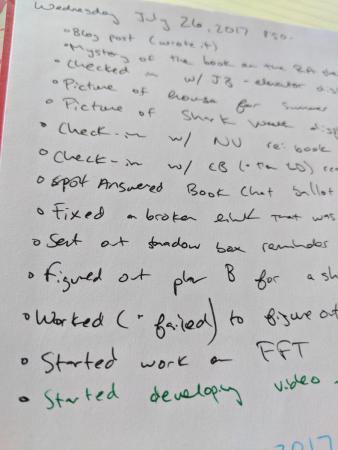Programming is the ultimate time balancing act. How do you do it all? If you’re like me, it’s a mix of very carefully planning and plunging wildly headfirst into your to-do list. Both require a level of organization that you have to consistently keep up with. Bullet journaling is my personal pie-in-the-sky of organization; however, I find it requires too much of a time commitment to do it exactly how I'd like to.
What is bullet journaling?
Bullet journaling is a creative organizational tool that you essentially design yourself. Using a blank journal you can draw your own calendars, create budget trackers and more. It generally suggests you make a list of things you want to accomplish for the month, then draw from that list to make weekly and daily to-dos. Everything exists in one notebook in the order you decide.
The four-minute video below gives a comprehensive look at bullet journaling.
For me, the concept of bullet journaling sounds intriguing — but also a bit rigid and overwhelming. So I've found a way to integrate some of its fundamental ideas into my workday in a way that gives me a bit more freedom. For example, instead of using one notebook, I break things up into three different organizational tools: a calendar with the monthly spreads, a notepad or notebook for my monthly or 14-day to-dos, and a scrap of paper.

The monthly calendar
This is the notebook that goes with me everywhere. I’m personally a fan of the Extra-Large Spiral Planners by Orange Color Studio, which I usually find at Homegoods in the summer. These are great because they allow you a snapshot of your month and have extra pages in the back for your daily outlines, if desired.
I only use this for the monthly calendar, where I put time-centric things, including program dates, meetings, publicity deadlines, specific reminders to send timely information, and other details along those lines. As you can see from the photo at left, I put slashmarks through the days when they pass.
The monthly or 14-day to-do list
For these lists, I use a separate notebook or sketchbook. I like to make a long list of everything I know I need to get done in the next two weeks or so. I like to check things off, so I typically break down the tasks into smaller tasks.
I keep my notes from meetings in this notebook as well. This way, I can add action items from the meetings I'm attending straight into the to-do list, rather than having to wait to add them later. Whatever isn’t finished is added to my future planning spread.
I do not follow the dot-circle-dash system that is recommended, but if I’m feeling fancy, I’ll add color coding by priority level or highlight the tasks with stricter deadlines. In particularly busy times, I’ll just eyeball what are priorities and what aren’t in the moment.
Many tasks are repeated often on this list, such as create Facebook post, add program stats to Sign Ups, or post book discussion questions. Others depend on where we’re at in the year and can range from writing a proposal for a new social media platform to mapping out new program dates.
Dailies
For my daily to-do list I prefer a piece of scrap paper that I can just recycle at the end of the day. To create these I draw from the larger to-do list, and when making them they tend to take an idealistic view of what I will get accomplished.
I prefer to do my dailies on a scratch piece of paper because I do not need to worry about making it pretty. It's also mobile, so not only can I mess up, but I can tape it on my computer screen so it is staring me down!
Reflection

One of my favorite suggestions for bullet journaling is to add a notes field to your day. Here you can write quick bullet points about what you did or what you were thinking about.
Reflection is an aspect I am trying to get better at, and adopting this method of just listing everything makes reflections more doable! Not only does writing it go quickly, but reading back over it to see the larger picture of where I spend my time goes quickly too. Typically I keep this in my monthly or 14-day to-do list notebook along with my notes.
Tips for using this methodology
Albeit imperfect, bullet journaling does help keep me tuned in to the larger picture, while at the same time honing in on the smaller tasks. Depending on how large the project I am working on is, I will follow this structure for specific projects I am working on, too.
Here are a few suggestions:
- Often bullet journalers use a system of adding indicators to their tasks. I have modified this to fit with my personal work goal of getting better at finding opportunities for other coworkers to join me in tasks (a.k.a. delegating). As I create my to-do lists, I try to keep an eye on which things only I can do, and which things I could bring someone else in to help with. Those I can mark with a special indicator to help spot trends later.
- If you have a thought that you need to do something, act on it. That action can be as little as making a note for you to do later, or as large as actually doing it. Most of the time when I think “oh, I’ll do that later” — surprise, surprise it doesn’t happen.
- Typically, when I'm driving home from work, or already at home, I'll have a great idea about something, or will remember I didn't do a task that needed to get done. What works the best for me is to email my work email address from home, so when I come in the next day I can put it on the to-do list.
- Be careful of using organizing as a procrastination tool!
No matter what, keep trying! You and your position are unlike anyone else's and, as a result, the way you organize will look differently too. For inspiration, check out these bullet journaling videos and see what can work for you:
- Bullet Journal Your Way by Buzzfeed Nifty
- My 2017 Bullet Journal Flip Through by AmandaRachLee
- Bullet Journal Flip Through by Boho Berry
- Planning for 2018: A Minimalist Bullet Journal for Productivity by Matt Ragland
- Plan With Me | February by Kalyn Nicholson



